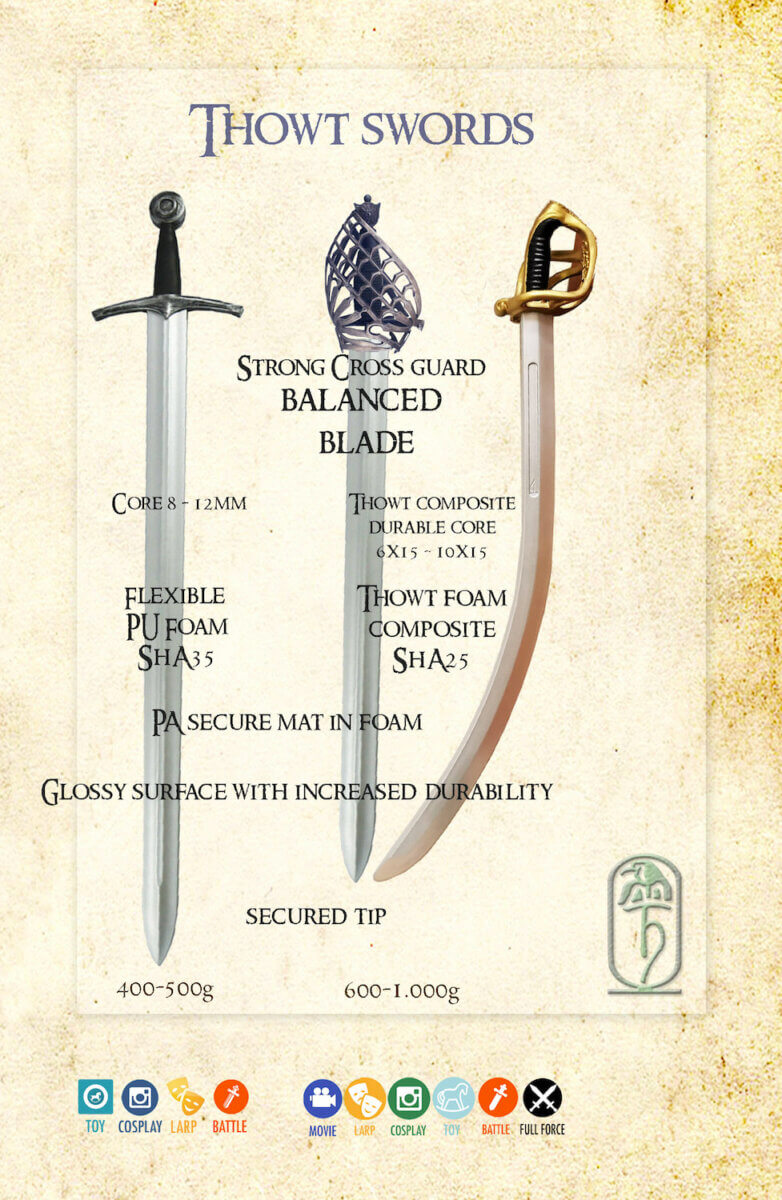Thowt is our brand of larp weapons  Since 2021, all new models have been marked by the cartouche of the divine blacksmith Thowt. Customers thus have a declared standardized quality. In the e-shop you will also find products from other manufacturers, or some weapons from older generations, but there is no Thowt cartridge.
Since 2021, all new models have been marked by the cartouche of the divine blacksmith Thowt. Customers thus have a declared standardized quality. In the e-shop you will also find products from other manufacturers, or some weapons from older generations, but there is no Thowt cartridge.
Material and hardness of the blades
Weapon cores are most often fiberglass rods, more expensive weapons tend to have carbon cores and the highest quality weapons have composite cores. Constructions and materials are a matter of constant testing and development and you will find all three in our offer.
To measure the softness hardness of the blades, we use the Shore A scale, which suits its range well.
The cores of our weapons
We make the core from a composite of fiberglass and carbon. For some extreme blades, polycarbonate is also part of the composite. For mainly older models, the cores are lighter – they have a circular cross-section of 6-12 mm, for newer models we use cores with a rectangular cross-section of 6 x 15 mm to 10 x 15 mm. They are heavier, harder and more durable.
Softening – polyurethane foam
The softening is made of polyurethane foam, inside which a polyamide mat is cast, and in some blades a mixture of polyamide and Kevlar – this protects the foam from tearing or tearing off the tip. On the surface of the softening, there is a thin, resistant layer close to thin skin. Its purpose is to increase the resistance of the blade surface.
The composition of the foam is a great alchemy and is generally one of the polyurethane foams. They can have very different properties – both different hardness and resistance to tearing and breaking. Quality foams are always soft, flexible and do not break. For a quick idea, they resemble rubber.
The foam has the advantage that it does not need to be maintained in any special way, it is not allergenic and has a much longer service life against latex. However, it is not completely inert to aging. It is resistant to UV light, but it is good to know that although many times more than latex, UV bothers the foam and the foam blade ages for years. So it is better to keep the weapon somewhere in the dark than exposed to the sun, the pedant will get a scabbard and reveal the blade only for combat. However, the foam is sensitive to temperature. It is not conducive to high temperatures above 50-60 degrees and becomes brittle, exposing it to frost. Therefore, if possible, do not leave it in a closed car in the summer, where the temperature can normally jump above 100 degrees, and if you are fighting outdoors on frosty days, keep in mind that foam at this temperature does not have the flexibility you are used to and will be damaged. much easier. In addition, it ages faster when exposed to frost.
Depending on the hardness, you will find the main groups of blades here:
A25 – these are weapons with quality design and top features. Our Thowt blades have a ShA of 20-25. They are soft, generally better accepted at major international games, we are working on continuous development. These are our current blades, as standard with a highly durable core 6×15 to 10×15 mm. They meet the requirements of all kinds of larps and larp battles, of course cosplay, and are also suitable for film and theater use. They are quite durable even for woodworks, kekel – hardcore full gear and full force battles. The foam used is as soft as latex, so the weapon will work even where latex weapons are prescribed.
A35 – Classic low cost universal larp weapons. ShA 35 have our standard blades of the first generation of our swords. It is a material that is durable, flexible and represents a good compromise for various uses. They have a nice design, are at great prices and are designed for larp combat, although they are not as durable as the previous ones. They are weapons usable for most types of larps, they have good resistance – they can withstand cosplay, soft battles. It is harder than latex, softening has a hardness of ShA35. It is for larps of all kinds, unsuitable for training and some models are not suitable for battles and woodworks. It is not ideal (but it can be used) for filming (it has a softer core blade on the camera “floats”.)
Some of our products have even softer foam and have a hardness of around ShA 10. Typically, these are hammers, mallets and similar weapons.
Handles and guards
For crossguards, it is always a choice. In general, flexible materials are used, which dampen the wound, but do not allow the classic work with a shield, which is known to swordsmen used to iron. Their advantage is safety. Also, at the vast majority of major international events, flexible crossguardssponsorships are not allowed. PP / PA sponsors tend to be at the upper end of admissibility.
In our offer of Thowt weapons, you will basically find two series: The first uses a flexible material (polyurethane) with Shore A 50-60 (hard rubber). The flexibility of the material gives it great resistance to breakage, but under extreme loads in kekel battles it can happen. That’s why we’ve created a special “Battle Series” for battles. It has polypropylene or polyamide crossguards with a Shore D hardness of around 60-70. Just to give you an idea – it is similar in hardness to wood, while polypropylene and polyamide have much better mechanical properties and resistance to wood. Above all, they are flexible and very tough, so it is really impossible to break them.
The crossguards of Thowt swords are different and you will find their material and hardness for each product in the description. Some are of different hard materials close to rubber, some are of polypropylene or polyamide. They are hard like wood – only they are many times more durable in all directions.
Wooden or hard resin shield is popular in Czech “kekel” “wood” battles. It behaves more like iron. The disadvantage is that it is not completely safe in more contact combat and they will not let you into the game with such a weapon and you will not find these crossguards on our products. We don’t even do metal shields. In fact, you won’t find anything on our weapons except metal balancing weights. We make them to meet CE certification as a toy. Which may sound surprising to larp battle participants, but it’s about making sure that game organizers are safe and that players with our weapons can be put into play.
All our weapons an shieelds are completely safe and meet the safety standards for the “toy” category. So they do not contain any metal elements, with one exception – and that is the weight of weapons, where it is explicitly stated that the weapon is balanced. In all cases, the elms are essentially plastic – it is either a stiffer PU foam or a foam combined with thermoplastics. The hardness of the foam at the elm is around Shore A 50. The metal weight of the balanced weapons is basically placed inside the handle – ie hidden in the palm of the fighter – and does not extend out of the palm (for example, into the head). So even a balanced weapon is completely safe even in contact combat.
Other materials that players ask
Latex
So latex is soft and safe from a certain point of view, but it has several problematic properties: Some people are allergic to latex, latex ages and becomes brittle, and it is usually necessary to maintain it, for example, by treatment with silicone.
Latex blades are among the softest and have a hardness of about ShA 20. We do not offer any latex weapons, latex are only some masks and other props – the material is always marked due to possible allergies.
EVA
In addition to latex, microporous rubber or EVA are most commonly used in home-made softening weapons. Microporous rubber and EVA have poorer resistance to abrasion and tearing, so they are most often glued with textile tape. Which is good for hardcore battles, but of course it detracts from the design and increases the hardness of the surface and needs to be replaced from time to time. Just to give you an idea – most home-built weapons have a surface hardness of around ShA 40-50. Which is the limit given by the textile tape.
Rigid polyurethane foams
On the market you will find a flood of mostly cheap weapons, which are nice in appearance, but the blade has a Shore A hardness of 50 or higher. At the same time, it is often a brittle foam that breaks. They can be used purely for cosplay (where, on the contrary, their mechanical properties are not a problem).


